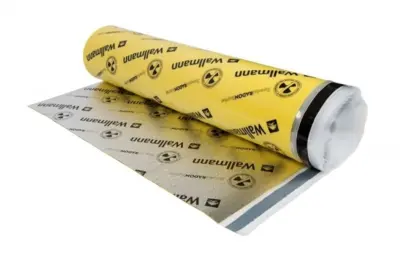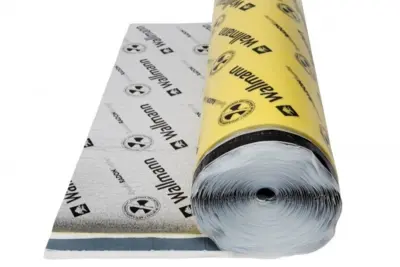No Noise Radon blocking floor underlay
3in1 substrate. (Noise reduction - Vapor barrier - Radon barrier) Specially developed Radon barrier floor underlay for floating floors, which has been tested by SBI Denmark. Reduce radon levels in your home using No Noise® Radon Barrier. Radon penetrates into houses, up from the underground. The purpose of the subfloor, which is installed under floating floors, is to improve protection in residential properties against the ingress of radon gas. The substrate is particularly suitable for renovation tasks in houses that were originally built without a radon barrier, but also houses with older radon barriers.
Thickness: 2.0 mm.
Format: 15.0 x 1.0 metres.
Per roll: 15.0 m²
Bearing capacity: 6.1 tonnes/m²
Compensation of unevenness: 1.2 mm
Suitable for underfloor heating: Yes
Sound insulation/Through sound: Up to 20 dB
Footstep sound reduction / Reverberation: Up to 12%
Density together with Radon Tape: q30 = 16.6 l/min. (At a differential air pressure of 30 Pa)
In addition to radon barrier, the substrate is also vapor barrier and provides good noise reduction.
REMEMBER: Special NO NOISE® Radon Barrier Tape must be used for top joints and along the wall.
Remember to read the installation instructions before installation. You will find it here
Facts about Radon:
What is radon?
Radon is a naturally occurring, radioactive gas that can enter the house from underground.
350,000 houses in Denmark are estimated to have too high a radon level.
Radon does not smell and cannot be seen or tasted, but it can be harmful to health with long-term exposure, and it is a contributing cause of approx. 300 cases of lung cancer per year.
The health risk of radon is approximately 25 times greater for smokers than for non-smokers.
Where does radon come from?
Most radon enters houses through cracks and fissures in foundations, living room floors and concrete decks, basement floors, outer walls in basements and leaks in pipe penetrations in foundations, etc.
What do I do about it?
If you measure over 100 Bq/m3, the Danish Energy Agency recommends that the radon level be reduced.
At radon levels between 100-200 Bq/m3, the Danish Energy Agency recommends that you reduce the radon level by improving ventilation and sealing cracks in the foundation and leaks at pipe joints.
At radon levels above 200 Bq/m3, it may be necessary to take more extensive measures, such as establishment of radon extraction (a special ventilation system under the building).
Also remember that the radon level is generally higher in the basement and ground floor, where there is direct contact between the floor and the ground. Basements in particular often have a worse indoor climate than the rest of the house, and basements are primarily intended for storage – not for living
Read much more at www.radonguiden.dk or www.radonfrithjem.dk
Radon protection is a legal requirement in new construction In 1998, a requirement was introduced in the building regulations that new construction must be radon protected. If your house was built after 1998, it is thus built with radon protection. Even if your house was built after 1998, radon levels may be too high in your house if the radon protection does not work. This may be because there is too little ventilation and air exchange in your house, or if the membrane in the foundation, which is supposed to ensure that radon does not penetrate from the ground, has been breached. Figures from Bolius' campaign show that approx. 30% of tested houses built after 2000 have a higher radon value than the authorities recommend. In the Building Regulations 2010, it is specified for new construction that the requirement for radon protection must ensure that the radon content does not exceed 100 Bq/m3 in the indoor climate. The owner of a house built after June 2010 is therefore entitled to ensure that the radon level does not exceed 100 Bq/m3. It is the professional builder who is responsible for ensuring that the radon protection complies with the requirement of max. 100 Bq/m3.













